
Traveling on a budget, I am always looking for a deal.
So when I read that the State Hermitage Museum – probably the most famous attraction in St. Petersburg – offers free admission on the first Thursday of each month, I decided to postpone my visit until the first Thursday in October – about three weeks after I arrived. In peak tourist season, I imagine the lines form an hour or more before the 10:30 a.m. opening time, but by October, I figured I would be okay arriving just shortly after ten.
I walked up Bolshaya Morskaya street from Nevsky Prospekt and through the large gateway of the General Staff Building into Palace Square. Approaching from this direction allowed me to take in the entire museum complex at once, colored in mint green and trimmed in gold. As I passed through the main gate from the Palace Square, I counted perhaps 30 people already in line, and as soon as the clock struck 10:30, they filed quickly through the revolving doors. It wasn’t long before I reached the ticket booth. Although general admission to the museum was free, the right to take photographs still cost 200 rubles and entrance via guided tour to either of the two Treasury Galleries – the Diamond and Gold Rooms – were an extra 300 rubles each. I decided to splurge on a tour of the Diamond Room – something I probably would not have done if I had paid the full admission price.
After handing over 500 rubles and receiving three nearly identical tickets in return (one for admission, one for a photo permit and one for the tour), I stepped past the ticket booths and immediately felt overwhelmed. There was a buzz surrounding me, groups gathering around their guides, people pushing past me, signs beckoning me to go one way or the other. I froze momentarily before collecting my thoughts and stepping over to the information desk to get an English map of the complex. Opening that and trying to digest three floors of color-coded exhibit topics just overwhelmed me even more.
I decided to take things slowly.
First, I needed to deposit my coat in the cloakroom because they do not allow outerwear in the museum. Next, looking at the time, I saw I had about 45 minutes until the tour of the Diamond Room began. Rather than try to speed through any exhibits, I decided to head to the café (my stomach was already rumbling a bit), grab an overpriced Snickers and Coke, peruse the map and develop a game plan for after the tour ended. I whipped out my Kindle and pulled up my Lonely Planet Russia guide and took notes on what it identified as major highlights. I perused my DK Eyewitness Top Ten guide as well and then made separate notes on other things that just seemed interesting.
The tour of the Diamond Room lasted just over an hour (that deserves its own post!) and by 1:00, I was ready to finally attack the Hermitage on my own.
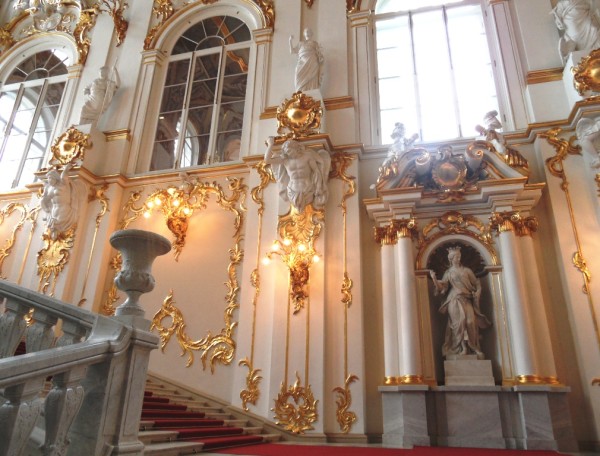

The Hermitage is enormous.
Founded by Catherine the Great in 1764, the museum houses nearly three million pieces of art in multiple buildings across St. Petersburg. By comparison, the Louvre has just 35,000. The main museum complex (what most people collectively call “the Hermitage”) consists of 365 rooms in the Winter Palace (the former residence of Russia’s tsars), the Small Hermitage, the Old Hermitage and the New Hermitage, all constructed in the 18th and 19th centuries.
My top priority was to see the Winter Palace interiors – the imperial state rooms and apartments. The lives of European royalty fascinate me and I have always enjoyed visiting royal palaces in cities like Vienna, Salzburg, Munich and Paris. It took me a while to get my bearings as not all of the rooms had numbers displayed and even those that did were not displayed prominently (I was very proud of myself that I managed to ask a museum guard where I was in Russian and I completely understood her response to me!). Only then did I realize that part of my confusion was due to the fact that several of the rooms were closed. Duh.
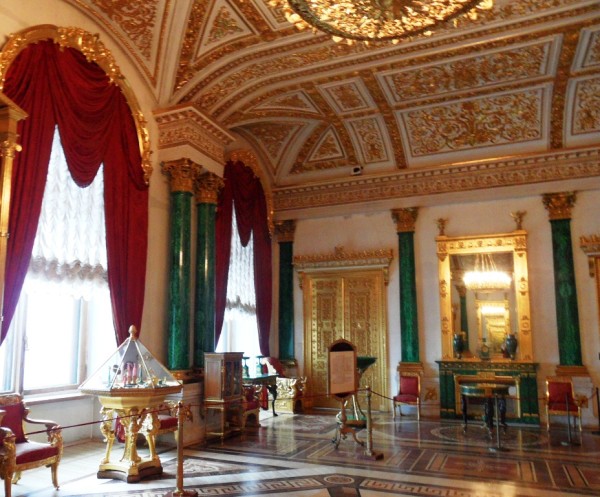
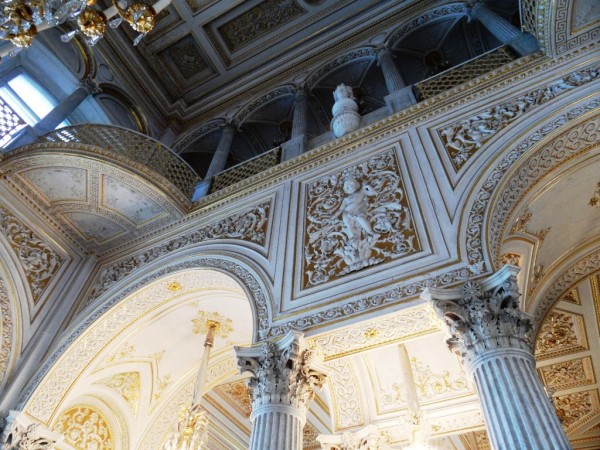
Now is the time for me to admit that I am not much of an art aficionado.
Sure, I have been to the Louvre (twice), the Musee d’Orsay, the Prado, and a number of other world renowned art museums. But in all honesty, I feel like once I have seen one Italian masterpiece, I have seen them all. I really can’t tell you what sets apart a Rembrandt or Van Gogh or Rubens from any random unknown painter. I took far more pictures of the ceiling decor at the Hermitage than I did any particular works of art.
So after I was done with the majority of the imperial apartments, I meandered through some Italian art and some French art only in an attempt to find additional apartments and halls that were in other corners of the complex, such as the Pavilion Hall. Sure, I stopped to check out the Raphael Loggias (a copy of the gallery in the Vatican Museums) but I was more interested in the War Gallery of 1812, a collection of portraits of the Russian military leaders who defeated Napoleon in the Patriotic War of 1812.
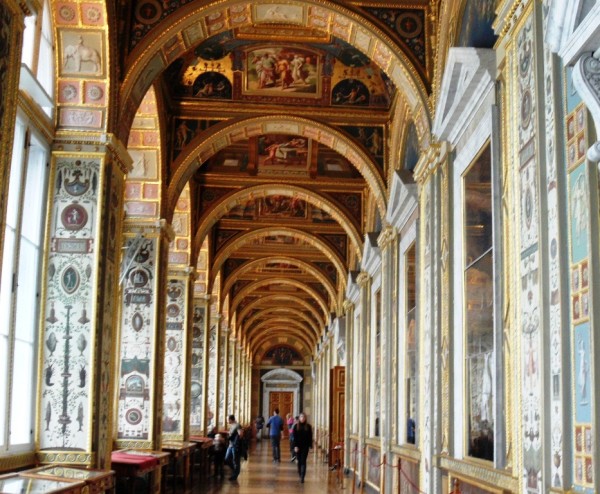
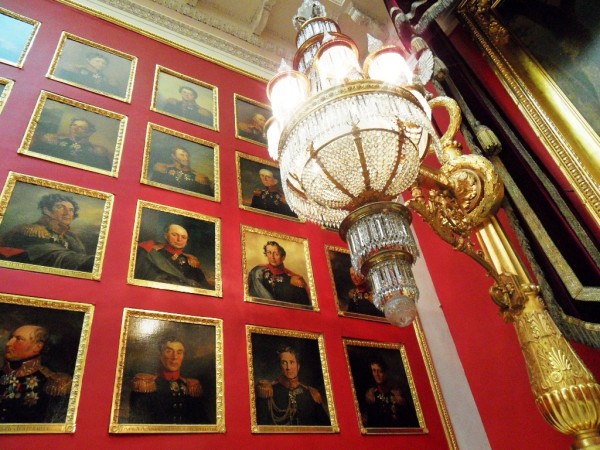
After I made it through almost the entire second floor (where I imagine most visitors spend most of their time), I made my way down to the first floor to see exhibitions from the Caucasus, Central Asia and Siberia. I sought them out with anticipation that they might provide a nice preview of what is yet to come on my Soviet Sojourn, but some ancient artifacts recovered from Tajikistan were all that stood out. Then, to my surprise, as I reached the exhibits on Siberia, I encountered what looked more like a storeroom than a museum gallery. I slowly continued down the hall anyway, past workers and wooden crates, feeling like I snuck into some off-limits storage area in the basement of the museum!
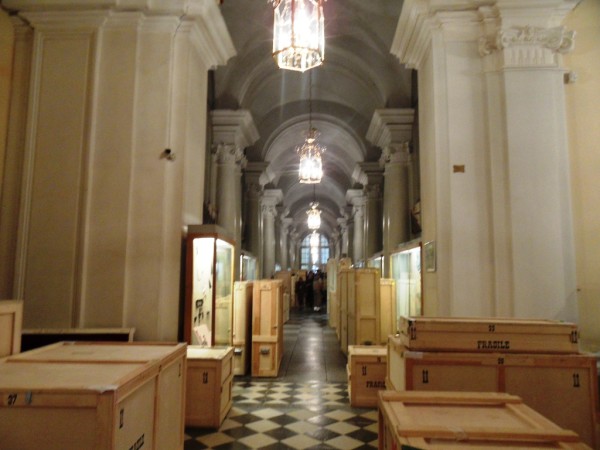
By the time I made my way back to the main entrance of the museum, it was 4:00 p.m. and I was nearing exhaustion. I took one last look at my map and realized I had covered a lot of ground – really, most of the museum. I at least walked through all the exhibition galleries on the second floor, whether enjoying the imperial apartments or rushing through German, Dutch and French art to other areas. I also checked out the third floor but the exhibitions that interested me the most (more art of Central Asia) seemed to be inaccessible. And I had covered most of the first floor, including passing through Roman and Greek sculptures on my way to and from the Diamond Room tour.
It was definitely time to call it a day.
